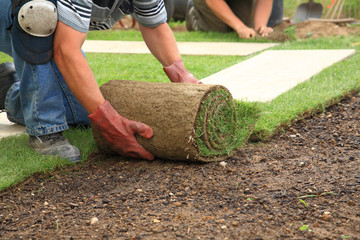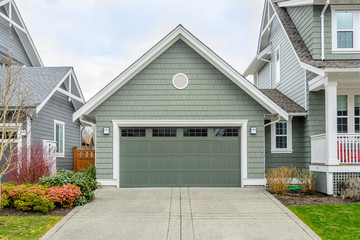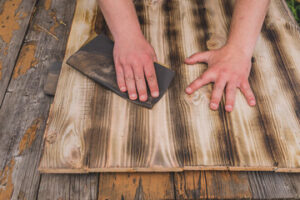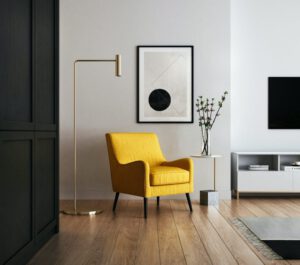Landscaping Springdale AR is the practice of designing and maintaining outdoor areas. It can raise property values, improve health and beauty, and provide enjoyment.

Landscaping differs from gardening in that it combines natural elements like plants and lawns with constructed features such as paths, walls and driveways. It also involves regular maintenance activities like mowing, fertilizing and pruning.
Irrigation is the application of regulated amounts of water to plants to meet their needs. It has been used for millennia to improve crop production, enhance outdoor aesthetics, and increase property value. It is important to understand how irrigation works before making a decision to install a system for your property.
Plants can’t survive without water. They rely on photosynthesis to convert sunlight into food, but the process requires abundant moisture for success. Without proper water management, plants can become stunted or die. Irrigation can help prevent plant disease and keep soils healthy by delivering the right amount of water when needed. It is also important to know how much water a plant can store near the roots so that watering can be planned accordingly.
A well-planned irrigation system will provide the necessary nutrients to promote healthy growth, maintain soil health, reduce the amount of chemical fertilizers required, and improve plant vigor. The most common types of irrigation systems include sprinklers, microirrigation, and subsurface drip systems. There are several factors to consider when deciding which system is best for your landscape, including soil type, climate, and field layout.
Whether you are looking to create a lush green space or a hardscape design, irrigation is an essential component of any landscaping project. Regular maintenance and care are critical to ensure that your landscape is healthy and attractive. A properly planned and maintained landscape not only increases the curb appeal of your home but also provides a variety of benefits that can make life more comfortable and enjoyable.
For example, trees can reduce the temperature in your yard by absorbing heat and releasing moisture, providing shade, and improving air quality. In addition, a landscaped yard can help you save on energy costs, reduce soil erosion, and increase your property value. The key to a successful landscaping project is choosing the right plants, soil, and irrigation system for your climate and sun/shade setting. Then, maintaining your yard with a consistent schedule of watering and trimming. It is also important to consider the needs of any wildlife that may live in your yard and choose plants that are suitable for their habitat.
Water Structures
Water structures can add an extra element of interest to your landscape. They may be ponds, fountains, or even pools. These features can also be used to create privacy and add a sense of luxury. Water structures also provide a great place to entertain guests.
The design and construction of in-water structures is regulated by State and Federal permitting agencies with jurisdiction. In addition, it is important to consider the full range of public interests and environmental concerns in the location and planning of in-water structures.
In-water structures should be designed to minimize impacts to ecological functions including water quality, anadromous and forage fish habitat, spawning and rearing areas, migration, passage, and waterway carrying capacity. They should not adversely affect hydrologic function including light penetration within the photic zone, sediment transport and current and water circulation patterns. They should also be located and planned to avoid obstructing public bathing, swimming and boating access points and scenic vistas.
Early in the planning process it is helpful to determine how you wish to use your landscape and what your goals are for each area. Some clients prefer to have a balance between dwelling and nature, others like to focus on a particular type of plant or activity.
Plants are an essential part of any landscape. They offer a variety of benefits including fruit and vegetable production, visual beauty, pleasant aromas, and shade. During the design phase it is important to choose appropriate plants for your environment taking into consideration their mature size and growing needs. It is also critical to allow for adequate space so that they can grow to their mature size without overcrowding your landscape.
The construction and maintenance of water structures is a complex and time-consuming task. They can be used for a variety of purposes, such as de-watering and diversion. De-watering is the removal of ground or surface water from a construction site, usually before subsurface excavation for foundations, shoring, cellar space and other activities that require dry conditions for safe working conditions. Diversion is the temporary (or possibly permanent) rerouting of water to another location for a variety of reasons including flood control and irrigation.
Outdoor Lighting
Whether your outdoor space is a backyard patio or an open front porch, lighting can make all the difference in the atmosphere. Target offers a variety of stylish, functional outdoor lighting options to suit any style and budget.
Adding a few key pieces can illuminate your outdoor spaces for evening dining, parties, and relaxing. Outdoor lighting can also improve safety by illuminating walkways, stairs, and driveways.
Lighting is a great way to show off your landscaping at night, too. String lights are an easy way to add a warm, whimsical glow to decks, patios, and gardens. They’re available in a wide range of colors and styles, and can be used with real or flameless candles to create the perfect look for any occasion.
Lanterns are another great option for adding a rustic, timeless feel to your spaces. They can be hung from a hook or bracket, mounted on a post, or placed on a table. They’re available in a wide variety of colors and styles, and can be used to brighten up a covered patio, entryway, or dining area. They’re also a great way to light up your garden for fall and winter, or to add a festive feel to holidays and parties.
If you’re looking for more directional or targeted lighting, outdoor pendant lights are a great choice. They’re a stylish and affordable way to illuminate outdoor seating areas, pathways, or artwork. Sconces are also a great way to highlight any features in your landscape, and can be easily moved to different areas as the sun moves across the sky.
Landscaping is more than just planting trees and flowers, it’s about creating a cohesive, visually appealing outdoor environment that enhances the beauty of your property and increases its value. By using both hardscaping and softscaping techniques, we can transform your outdoor spaces into beautiful, comfortable living areas that will be enjoyed by your family and friends for years to come.
Softscapes
Softscapes are all of the plants, grasses, shrubs and flowers that add natural beauty to your landscape. They are the living component of your yard and require regular attention. They also provide the color and fragrance that makes your yard feel like a calming, inviting retreat.
Softscapes, particularly trees, create the sense of depth and privacy that define your outdoor space. They can be planted around patios, pools and other hardscape features to soften their appearance and create a unified look. They are also the foundation of any landscape, forming the base layer upon which the other elements are placed.
While hardscapes can help to anchor a garden and prevent erosion, it is essential to balance them with softscapes to maintain a healthy environment. Grass and ground covers protect the topsoil from wind and sun damage, keeping it in place and helping to reduce soil erosion. Mulching, a common softscape practice, retains moisture in the soil, stops weeds from growing and prevents frost heaving during winter.
Unlike hardscapes, softscapes can easily be changed to suit your tastes and needs. You can replace plants, add new perennials or annuals to create different color schemes and give your yard a fresh, lively look from season to season. Annual flowers such as lilies, zinnias and pansies are especially versatile, offering the opportunity to completely rework the look of your flower beds each year.
A well-designed yard has both hard and softscapes to balance utility with beauty and create a unified space that fits your lifestyle. The best way to find the right balance is to start with a purpose in mind and work with a professional to achieve it. For example, a patio and fire pit might be key hardscape features for entertaining guests, but they can be balanced with surrounding shrubs and flowers to create a calm and serene outdoor oasis where you can relax.

















